Ash Mint Slipover |
||||||||||||||||
 |
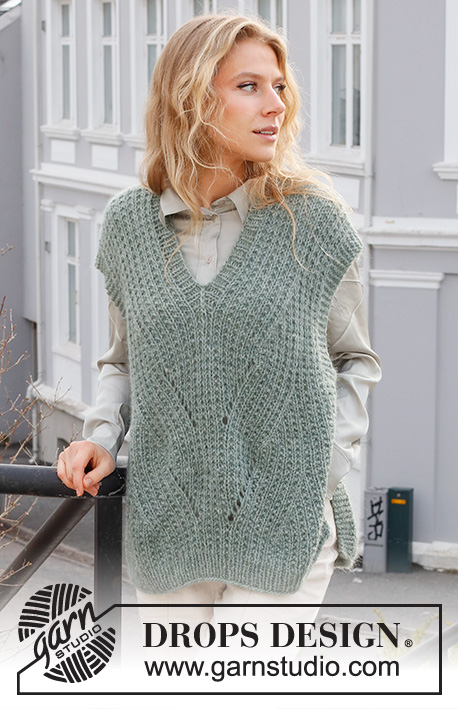 |
|||||||||||||||
Knitted vest / slipover in DROPS Sky and DROPS Kid-Silk. Piece is knitted with V-neck pattern, vents in the sides, textured pattern and displacements. Size XS – XXL.
DROPS 227-31 |
||||||||||||||||
|
---------------------------------------------------------- EXPLANATION FOR THE PATTERN: ---------------------------------------------------------- GARTER STITCH (back and forth): Knit all rows. 1 ridge vertically = knit 2 rows. PATTERN: See diagrams A.1 to A.5. Diagrams show all rows in pattern seen from the right side. DECREASE TIP: All decreases are done from the right side! Work 6 stitches in garter stitch, slip 1 stitch knitwise, knit 1, pass slipped stitch over stitch worked(= 1 stitch decreased), work until 8 stitches remain, knit 2 together(= 1 stitch decreased), work 6 stitches in garter stitch. ---------------------------------------------------------- START THE PIECE HERE: ---------------------------------------------------------- VEST – SHORT OVERVIEW OF THE PIECE: Work back piece and front piece back and forth on circular needle. Then assemble the vest by sewing it together on the shoulders and down the side seams. Finish with a neck edge in round on a circular needle. BACK PIECE: Cast on 73-77-85-89-97-105 stitches on circular needle size 4.5 mm with 1 strand of each colour (= 2 strands). Purl 1 row from wrong side. Then work rib as follows: 6 stitches in GARTER STITCH - read explanation above - * knit 1/purl 1 *, repeat from *-* until 7 stitches remain, knit 1 and 6 stitches in garter stitch. Continue rib back and forth like this for 4 cm. Switch to circular needle size 5.5 mm. Now work pattern as follows: 6 stitches in garter stitch, work A.1 (= 2 stitches) until 7 stitches remain, work first stitch in A.1, 6 stitches in garter stitch. REMEMBER THE KNITTING TENSION! Continue back and forth like this until piece measures 29-30-31-32-33-34 cm. Now work in garter stitch over the outermost 8-8-10-10-10-10 stitches in each side. When 2 ridges have been worked over these stitches, cast off 2-2-4-4-4-4 stitches for armholes at the beginning of the next 2 rows = 69-73-77-81-89-97 stitches. In sizes XS, S, M and L skip next section and continue to work from ALL SIZES – read explanation below. In sizes XL and XXL work as explained below. SIZE XL AND XXL: Now decrease 1 stitch inside 6 stitches in garter stitch in each side- read DECREASE TIP. Decrease like this on every row from right side 4-6 times in total = 81-85 stitches. ALL SIZES: Continue back and forth with A.1 and 6 stitches in garter stitch in each side. When piece measures 56-58-60-62-64-66 cm, cast off the middle 19-19-19-23-23-23 stitches for neck and finish each shoulder separately. Then cast off 1 stitch on next row from the neck = 24-26-28-28-28-30 stitches remain for shoulder. When piece measures 58-60-62-64-66-68 cm, cast off with knit over knit and garter stitch over garter stitch. Work the other shoulder the same way. FRONT PIECE: Cast on 73-77-85-89-97-105 stitches on circular needle size 4.5 mm with 1 strand of each colour (= 2 strands). Purl 1 row from wrong side. Then work rib as follows: 6 stitches in garter stitch, * knit 1, purl 1 *, work from *-* until 7 stitches remain, knit 1, 6 stitches in garter stitch. Continue back and forth like this for 4 cm. Switch to circular needle size 5.5 mm. Now work pattern as follows: 6 stitches in garter stitch, work A.1 (= 2 stitches) until 7 stitches remain, work first stitch in A.1, 6 stitches in garter stitch. Continue back and forth like this. When piece measures 9-9-10-10-11-11 cm, work pattern as follows: Work 6 stitches in garter stitch, A.1 as before over the next 5-7-11-13-17-21 stitches, A.2 over the next 22 stitches, A.1 as before over the next 7 stitches (the middle of these 7 stitches is middle stitch on front piece = a knit stitch), A.3 over the next 22 stitches, A.1 as before over the next 5-7-11-13-17-21 stitches, 6 stitches in garter stitch. Continue back and forth like this until piece measures 29-30-31-32-33-34 cm. Now work in garter stitch over the outermost 8-8-10-10-10-10 stitches in each side. When 2 ridges have been worked over these stitches, cast off 2-2-4-4-4-4 stitches for armholes at the beginning of the next 2 rows = 69-73-77-81-89-97 stitches. OVERVIEW OF NEXT SECTION: Then work as explained below in the next sections - choose section for your size. SIZE XS, S, M and L: Divide the piece for right and left front piece, at the same time work pattern and decrease for V-neck as explained below. PATTERN AND DECREASE FOR V-NECK: Continue to work with 6 stitches in garter stitch towards the side and pattern as before over the remaining stitches. When A.2 and A.3 have been worked vertically 2 times in total, work A.4 over A.2 and A.5 over A.3 (continue the remaining stitches as before). Decrease in A.4 and A.5 is decrease for V-neck. When A.4 and A.5 have been worked vertically, continue decrease the same way until 10-10-10-12 stitches have been decreased in total (on each front piece). DIVISION FOR RIGHT AND LEFT FRONT PIECE: When piece measures 37-38-39-40 cm, divide the piece for right and left front piece by slipping middle stitch and the stitches for the other side of front piece on a thread (middle stitch = 1 knit stitch). Then work each shoulder separately with pattern and decrease as explained above (divide the piece before all decreases in pattern are done). When all decreases for V-neck are done, 24-26-28-28 stitches remain for shoulder. Continue to work until piece measures 58-60-62-64 cm. Cast off with knit over knit and purl over purl. Work the other shoulder the same way. SIZE XL AND XXL: Decrease stitches for armhole, at the same time divide the piece for right and left front piece, and work pattern and decrease for V-neck as explained below. DECREASE FOR ARMHOLES: Now decrease 1 stitch inside 6 stitches in garter stitch in each side the same way as on back piece - remember DECREASE TIP. Decrease like this on every row from right side 4-6 times in total = 81-85 stitches. PATTERN AND DECREASE FOR V-NECK: After last decrease for armhole continue to work with 6 stitches in garter stitch towards the side and pattern as before over the remaining stitches. When A.2 and A.3 have been worked vertically 2 times in total, work A.4 over A.2 and A.5 over A.3 (continue the remaining stitches as before). Decrease in A.4 and A.5 is decrease for V-neck. When A.4 and A.5 have been worked vertically, continue decrease the same way until 12-12 stitches have been decreased in total (on each front piece). DIVISION FOR RIGHT AND LEFT FRONT PIECE: When piece measures 41-42 cm, divide the piece for right and left front piece by slipping middle stitch and the stitches for the other side of front piece on a thread (middle stitch = 1 knit stitch). Then work each shoulder separately with pattern and decrease as explained above (divide the piece before all decreases are done). When all decreases for V-neck are done, 28-30 stitches remain for shoulder. Work until piece measures 66-68 cm. Cast off with knit over knit and purl over purl. Work the other shoulder the same way. ASSEMBLY: Sew shoulder seams inside cast-off edges. Sew side seam in outermost loop of edge stitches from armhole and down until approx. 17 cm remain (= vent). Repeat in the other side. NECK EDGE: Begin at one shoulder seam and pick up from right side approx. 106 to 130 stitches inside 1 edge stitch in garter stitch around the neck on a short circular needle size 4.5 mm with 1 strand in each quality (= 2 strands). Work rib in the round (= knit 1/purl 1) - but adjust so that middle stitch at the front is knitted and that rib fits the entire round. Insert 1 marker in middle stitch at the front. AT THE SAME TIME on every round decrease 2 stitches mid front as follows: Work until 1 stitch remains before stitch with marker, slip the next 2 stitches knitwise, knit 1, pass the 2 slipped stitches over stitch worked (= 2 stitches decreased). When decreasing like this the knit stitch in the middle of V-neck will follow as a straight line mid front. Decrease like this every round until neck edge measures approx. 3 cm in knitting direction. Cast off stitches with knit over knit and purl over purl. |
||||||||||||||||
Diagram explanations |
||||||||||||||||
|
||||||||||||||||
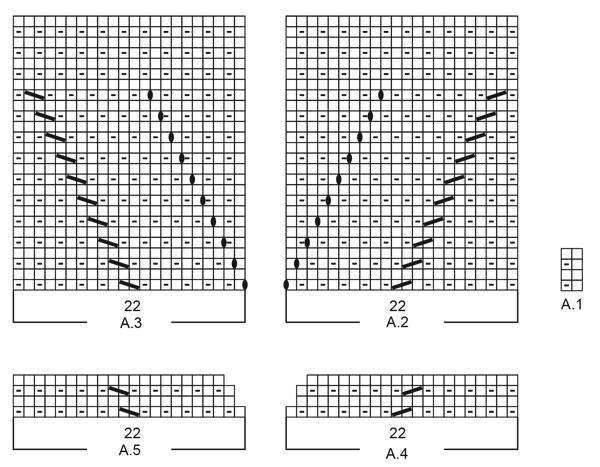
|
||||||||||||||||
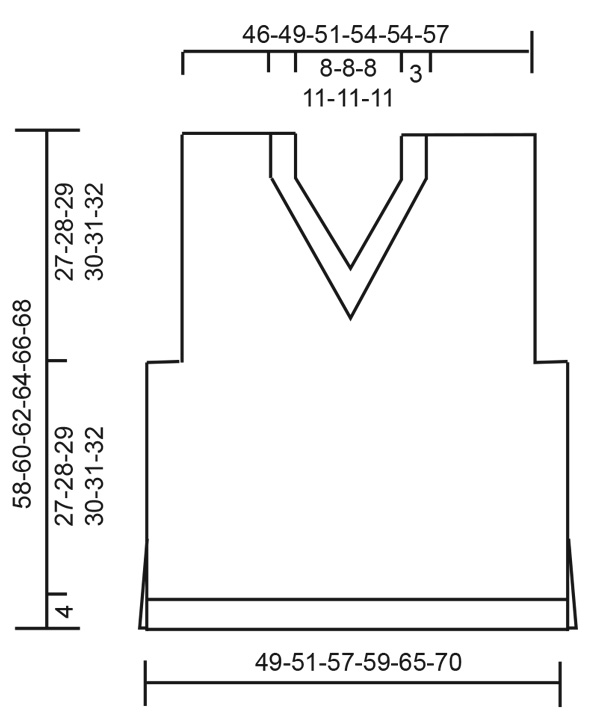
|
||||||||||||||||
|
Have you made this or any other of our designs? Tag your pictures in social media with #dropsdesign so we can see them! Do you need help with this pattern?You'll find tutorial videos, a Comments/Questions area and more by visiting the pattern on garnstudio.com. © 1982-2024 DROPS Design A/S. We reserve all rights. This document, including all its sub-sections, has copyrights. Read more about what you can do with our patterns at the bottom of each pattern on our site. |
||||||||||||||||







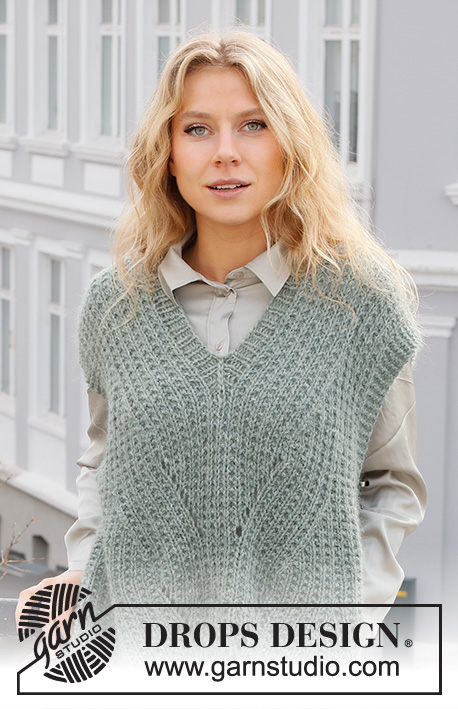
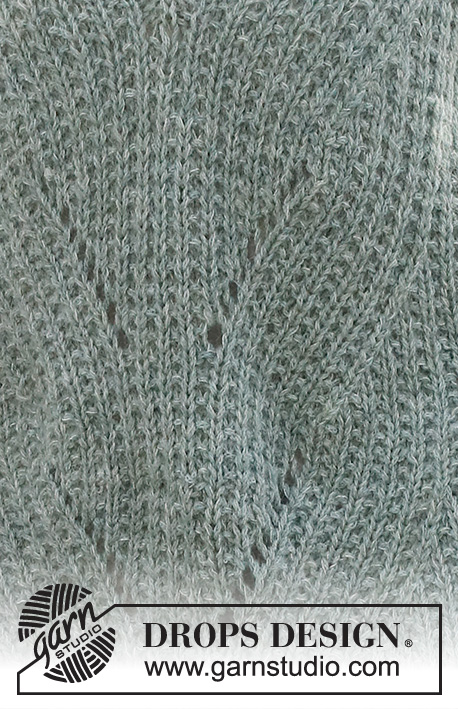

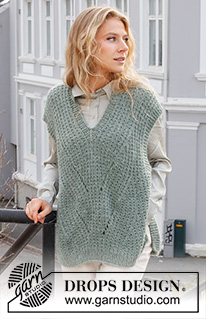
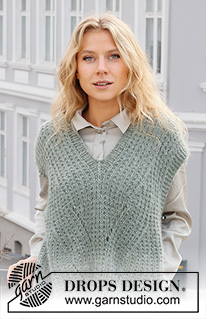













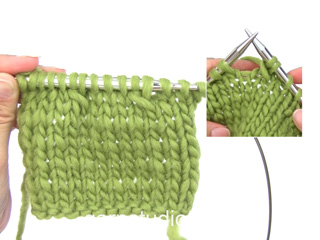
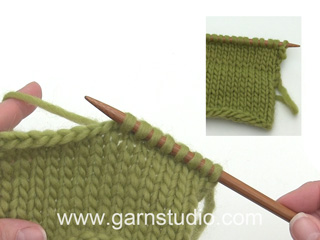







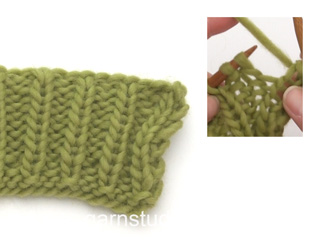


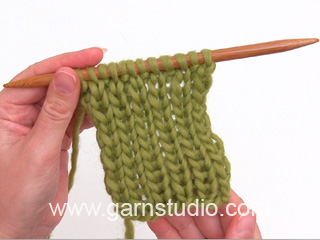























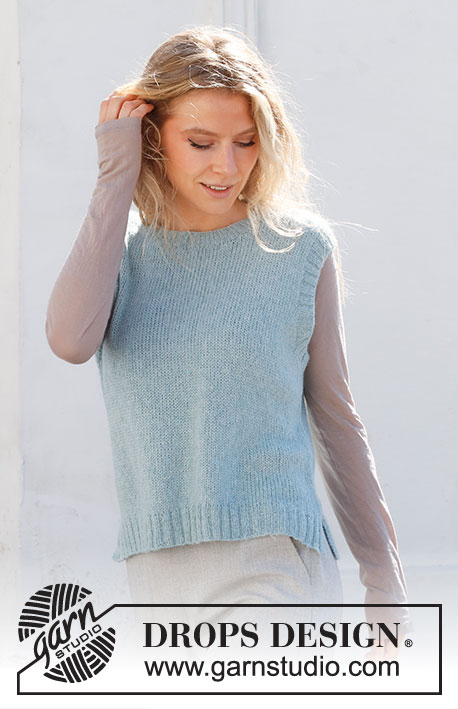






Comments / Questions (31)
De vraag is hierboven al gesteld maar niet beantwoord.dus nogmaals ik heb dezelfde vraag \r\nMijn A2-A3 patroon komt na 2x gebreid gelijk met armsgat=34cm, nog 8cm breien alvorens splitsing V-hals. Moet het A4-A5 patroon (slechts 4 naalden) direct aansluiten op A2-A3 (2cm) of vlak bij de splitsing komen? In beide gevallen, moet ik nog 6 cm overbruggen, brei ik dat dan in A1?\r\nIk kijk uit naar uw antwoord Met dank anne
05.04.2022 - 20:16DROPS Design answered:
Het begin van de V-hals valt ongeveer samen met het begin van het armsgat, dus je hoeft geen 6 cm te overbruggen; je kunt gelijk verder gaan met A.4 over A.2 en A.5 over A.3.
07.04.2022 - 23:29Mijn A2-A3 patroon komt na 2x gebreid gelijk met armsgat=34cm, nog 8cm breien alvorens splitsing V-hals. Moet het A4-A5 patroon (slechts 4 naalden) direct aansluiten op A2-A3 (2cm) of vlak bij de splitsing komen? In beide gevallen, moet ik nog 6 cm overbruggen, brei ik dat dan in A1?\r\nDank u voor de raad!\r\nJesse
29.03.2022 - 10:35Hallo, ich möchte gerne diesen Pullunder stricken. Leider vertrage ich weder Mohair, noch Alpaka oder sonstige Wollarten auf der Haut. Gibt es eine Alternative als Baumwollgarn? Ich benötige einen möglichst dunklen Braunton. Herzlichen Dank für eine Antwort Annelie Weigand
24.03.2022 - 19:25DROPS Design answered:
Liebe Frau Weigand, benutzen Sie den Garnumrechner, um die unterschiedlichen Garnalternative für beide Garne zu finden; gerne wird Ihnen Ihr DROPS Laden damit helfen, die besten passenden Garne zu finden. Viel Spaß beim stricken!
25.03.2022 - 07:46Uit hoeveel naalden bestaat het tel patroon. Klopt het dat de teruggaande toer van telpatroon telkens averechts is op de verkeerde kant van het werk.
08.02.2022 - 20:38DROPS Design answered:
Dag Anne-Marie,
In de telpatronen zijn alle naalden weergegeven, dus zowel de heengaande als de teruggaande naalden. De teruggaande naald is in dit geval inderdaad steeds averecht aan de verkeerde kant.
11.02.2022 - 14:31Tak for jeres svar. Dvs sige jeg skal strikke med 2 strand ?
07.02.2022 - 12:25DROPS Design answered:
Hei Annette. Ja, oppskriften strikkes med 2 tråder. God Fornøyelse!
07.02.2022 - 14:39Hej, hvis jeg vil strikke den vest med kun et enkelt garn, hvilket vil I så anbefale? Tak
06.02.2022 - 22:18DROPS Design answered:
Hei Annette. Vi har nok ingen kvalitet med den strikkefastheten /pinne nr, der du kan byttet ut DROPS Sky og DROPS Kid-Silk. mvh DROPS Design
07.02.2022 - 12:03Als ik de foto zie en het patroon lees dan komt dit niet overeen m.i. er staat de telpatronen laten alle naalden in het patroon aan de goede kant zien. Volgens de foto heb ik nu de verkeerde kant als voorkant.
01.01.2022 - 13:49Buongiorno, non capisco le diminuzioni per lo scollo. C'è un video a riguardo? Grazie
30.11.2021 - 12:23DROPS Design answered:
Buonasera Loredana, quale parte della spiegazione delle diminuzioni non le è chiara? Buon lavoro!
07.12.2021 - 21:51Bonjour, j'essaie de réaliser ce patron mais lorsque je commence le diagramme A.1 je me retrouve à faire mon tricot en mailles jersey est-ce normal ou s'il y a quelque chose que je ne comprend pas. J'ai commencé sur l'endroit et recommencé sur l'envers mais le résultat reste le même. Merci de m'éclairer SVP.
19.11.2021 - 20:49DROPS Design answered:
Bonjour Mme Bouchard, le diagramme A.1 se tricote ainsi: 1 maille jersey (= la 1ère m de A.1, à tricoter à l'endroit sur l'endroit et à l'envers sur l'envers) et 1 maille point mousse (à tricoter toujours à l'endroit), autrement dit, vous obtenez ainsi des côtes 1 m end, 1 m point mousse (vu sur l'endroit) - peut-être que la dernière photo du motif zoomé pourra vous aider à bien visualiser ce qu'il rend. Le 1er rang se tricote sur l'endroit. Bon tricot!
22.11.2021 - 07:31Voor voorpand moet ik tot 31 cm breien. Dan voor maat M moet ik het werk verdelen in linker en rechter voorpand. Vervolgens minderen voor de hals. Verderop staat dat bij 38 cm het werk in linker en rechterpand moet worden verdeeld. Dit begrijp ik niet. Dat heb ik toch al na ca. 31 cm gedaan.
17.11.2021 - 12:56DROPS Design answered:
Dag Avelien,
Vanaf een hoogte van 31 steken heb je ribbesteken over de buitenste steken gebreid, dat is dus bij de armsgaten en niet midden voor. Pas vanaf een hoogte van 39 cm verdeel je het werk voor het rechter en linker voorpand.
23.11.2021 - 12:57